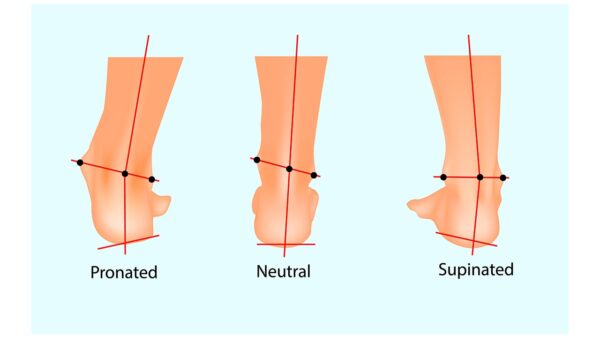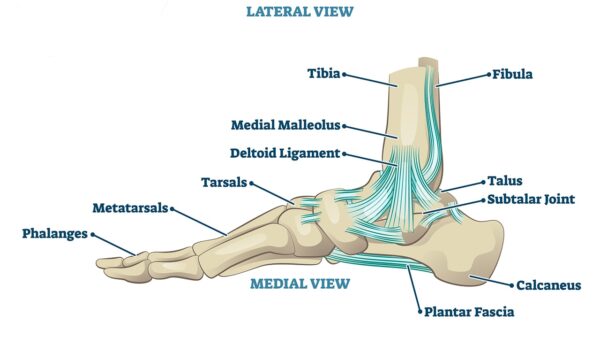Collapsed Ankle: Why It Happens And What To Do About It

Medically Reviewed By:
As we age, our bodies naturally change, and one common issue that can arise is a collapsed ankle, often resulting from the weakening of structures that support the foot arch. This weakening can lead to pronated feet, where the arches flatten, causing the ankles to roll inward. This inward rolling contributes to discomfort, pain, and reduced mobility.
Interestingly, research has shown that women are more prone to foot and ankle issues like collapsed arches. Studies report that around 35.61% of women experience pronated feet, compared to 11.32% of men.
This article will explore the causes, early symptoms, and treatment options for collapsed ankles, from conservative approaches to more advanced interventions. Understanding the condition is the first step toward effectively managing it.
Exploring Ankle Anatomy And The Impact Of Collapse

The ankle is a complex joint composed of bones, ligaments, and tendons that work together to provide stability and support during movement. When the inside of the ankle collapses inward, it disrupts the joint’s natural balance. This condition is known as ankle pronation.
The video below illustrates the impact of pronation, the opposite of ankle supination (when the ankle rolls outward), by focusing on the inside of the left ankle.
In a healthy ankle, the inner deltoid and spring ligaments are critical for maintaining the arch and preventing excessive inward rolling. However, when these ligaments weaken or become loose, they fail to provide sufficient support, leading to arch collapse and inward pronation.

The effects of this collapse go beyond the ligaments, impacting the muscles and tendons that stabilize the foot and ankle. Over time, the strain caused by a collapsed ankle can lead to pain, inflammation, and, if left unaddressed, potentially long-term joint damage.
Common Causes Of A Collapsed Ankle
A collapsed ankle can result from various underlying issues, each affecting the anatomy and function of the ankle in different ways. Understanding the common causes helps determine the right treatment approach and prevent further complications.
Injury-Related Causes
Injuries to the ankle, particularly those involving the ligaments, tendons, or bones, can significantly contribute to ankle collapse. Sprains, fractures, or overuse injuries may weaken the structures that support the foot arch.
Degenerative Conditions
Over time, wear and tear on the ankle’s ligaments, tendons, and cartilage can lead to degenerative conditions that affect the joint’s stability.
Posterior Tibial Tendon Dysfunction (PTTD)
One of the most common causes of ankle collapse is PTTD, which occurs when the posterior tibial tendon, which supports the arch, becomes inflamed or torn.
Osteoarthritis
Osteoarthritis, a condition marked by the breakdown of cartilage within joints, can affect the ankle, leading to pain, swelling, and joint instability.
Rheumatoid Arthritis
Rheumatoid arthritis, an autoimmune condition that causes inflammation in the joints, can weaken the ligaments and tendons supporting the arch, contributing to ankle collapse.
Other Contributing Factors
Beyond injuries and degenerative conditions, other factors can also contribute to the collapse of the ankle.
- Excessive weight: Carrying excess body weight places additional stress on the ankle and foot, increasing the likelihood of ligament and tendon strain.
- Flat feet: Individuals with flat feet are at higher risk of experiencing ankle collapse, as the natural arch is already compromised. Without proper support, the ankle may pronate inward during physical activity, leading to further complications.
- Biomechanical imbalances: Imbalances in the foot and ankle’s movement, such as overpronation or poor alignment, can place uneven pressure on the ligaments and tendons.
Spotting The Early Signs And Symptoms Of Ankle Collapse
One of the first indicators of ankle collapse is a visible change in the foot’s appearance, such as inward rolling of the ankle (pronation), flattening of the arch, and noticeable alignment differences when standing or walking. These changes often become more pronounced when weight is placed on the affected foot.
- Noticeable changes in appearance: The first visible signs of the condition include inward rolling of the ankle, flattening of the arch, and an obvious foot misalignment when standing or walking.
- Discomfort and inflammation: As the ankle weakens, discomfort, swelling, and inflammation often develop around the joint, especially after physical activity or prolonged standing.
- Limited range of motion: Limited range of motion is common, as weakened ligaments and tendons struggle to maintain flexibility and support. A collapsed ankle can further disrupt normal joint alignment, reducing the ankle’s range of motion.
- Lower back pain: Many individuals experience pain radiating beyond the ankle, often involving the lower leg, knee, and lower back.
- Foot flattening: A sensation of the foot flattening when walking or standing occurs because the arch collapses as the ligaments and tendons fail to provide adequate support.
Diagnosis
Medical professionals use various methods to assess the joint’s alignment and function when diagnosing a collapsed ankle. A physical examination includes observing the ankle during standing, walking, and other movement to detect signs of pronation, arch collapse, and gait issues.
Range of motion tests are performed to check for stiffness or restrictions, while imaging tests such as X-rays and MRIs help examine the bone structure and soft tissues. Weight-bearing assessments evaluate ankle alignment under normal load, and gait analysis is used to observe walking patterns and identify compensatory movements and instability.
How Do You Treat a Collapsed Ankle?
Treating a collapsed ankle involves a combination of non-invasive therapies and, in more severe cases, surgical intervention. The goal of treatment is to reduce pain, restore stability, and prevent further deterioration of the ankle joint.
Below are conventional treatment options commonly recommended by healthcare providers:
- Physical therapy (PT): PT can help strengthen the ankle muscles and improve flexibility and stability. Physical therapists may provide exercises to restore balance and support the foot and ankle.
- Foot orthotics: Orthotics can provide support to weakened foot structures, as elevating the arch and improving alignment alleviate ankle pressure, promote better posture, and reduce strain.
Support Ankle Function With The Regenexx Approach
The Regenexx approach uses interventional orthobiologics to support the body’s natural healing abilities in addressing ligaments, tendons, and cartilage issues. This non-surgical alternative to traditional orthopedic surgery may help individuals improve function and reduce pain with minimal downtime compared to surgery.
Procedures using Regenexx lab processing aim to enhance ankle function by promoting the body’s natural ability to heal, offering a less invasive alternative for long-term joint health compared to surgery.
What if I Leave a Collapsed Ankle Untreated?
Leaving a collapsed ankle untreated can lead to significant long-term consequences. Weakened ligaments and tendons on the inside of the ankle cause excessive pressure on the outside of the joint, potentially resulting in arthritis.
Continued activity without treatment accelerates wear and tear, leading to chronic pain and potential loss of mobility. Immediate treatment is crucial to prevent further deterioration.
Early treatment of these issues is essential to avoid the multiple injuries often associated with aging.
Regenexx For Ankle Care
If you are experiencing ankle issues, the Regenexx approach offers innovative, regenerative therapeutic solutions to help improve function and reduce pain. Procedures using Regenexx injectates utilize interventional orthobiologics to support the body’s natural healing process, offering an alternative to conventional treatments by potentially reducing the need for surgery or prescription medications.
Learn how a physician in the licensed Regenexx network may be able to help you address a collapsed ankle through non-surgical alternatives.
Get started to see if you are a Regenexx candidate
To talk one-on-one with one of our team members about how the Regenexx approach may be able to help your orthopedic pain or injury, please complete the form below and we will be in touch with you within the next business day.
References
(1) Hunt MA, Takacs J, Krowchuk NM, Hatfield GL, Hinman RS, Chang R. Lateral wedges with and without custom arch support for people with medial knee osteoarthritis and pronated feet: an exploratory randomized crossover study. J Foot Ankle Res. 2017;10:20. Published 2017 May 2. doi:10.1186/s13047-017-0201-x
(2) Golightly YM, Hannan MT, Dufour AB, Hillstrom HJ, Jordan JM. Foot disorders associated with overpronated and oversupinated foot function: the Johnston County osteoarthritis project. Foot Ankle Int. 2014;35(11):1159-1165. doi:10.1177/1071100714543907

Medically Reviewed By:
